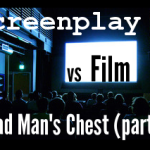In my previous post, How to Write a Script Outline: the 8 Major Plot Points, I described the 8 plot points that can be found in basically EVERY movie. So it makes sense for you to spend a significant chunk of time thinking about them when you write a script outline. Figuring these 8 plot points ahead of time will also make writing your screenplay a thousand times easier.
But in my already lengthy post, I didn’t have time to include examples. So today, I’m going to use the first of the Lord of the Rings trilogy, The Fellowship of the Ring, to give examples of the 8 essential plot points. Some of you might not have seen Lord of the Rings, *gasp* so I’m going to describe people and places you might not be familiar with. For everyone who has seen it (the majority I bet), please excuse the clarifications. Here’s the link again, in case you want a refresher of the 8 plot points you need to think about before you write a script outline.
Plot Point #1: Opening & Closing Images
The first image in the Fellowship of the Ring is a picture of a smoldering crucible. (A crucible is just a nifty container you can melt metal in.)

Opening Image from THE FELLOWSHIP OF THE RING
The goal of our hobbit hero, Frodo, is to destroy the One Ring in the fires of Mordor, turning it into molten metal again. That’s why this opening image is so perfect. It symbolizes the entire goal and journey of the main character.
From the get-go, Fran Walsh, Philippa Boyens & Peter Jackson showed us how skillfully they adapted such a treasured literary work. No wonder they nabbed so many Oscars. (Remember this if you’re also interested in adaptations.)
The closing image is of Frodo and his sidekick, Sam, rowing off to face the next part of their journey. This image isn’t as powerful as the opening one, but it serves its purpose: it indicates that Frodo and Sam haven’t finished their journey, but whatever evil they’ll encounter next, they’ll face it together.
So the closing image makes a statement about the power of friendship, one of the recurring themes in the LOTR trilogy. It also makes us curious to see if they’ll succeed…whetting our appetite for the next installment.
Plot Point #2: Inciting Incident
Frodo, our hero, is going about his business in the Shire, where all the hobbits live. (For those of you unfamiliar with hobbits, they’re little people who live in a network of burrows. They’re generally peaceful and not materialistic.)
And his life would’ve continued as usual…if his uncle Bilbo hadn’t decided to leave the Shire and give the One Ring to Frodo. Once the ring enters Frodo’s life, it utterly changes his destiny. Instead of idle days smoking pipe-weed, Frodo will instead face danger and pain. Click on this link for more examples of inciting incidents.
Plot Point #3: First Act Break
Naturally, Frodo isn’t keen to embrace this responsibility. The great wizard Gandalf finally convinces Frodo that he must at least take the ring out of the Shire.
When Frodo leaves, he is joined by his best friend, Sam, and two other hobbits, Pippin and Merry. In this first act break, we see the beginnings of the fellowship, although it’s not yet in its full form. Note too, that the first act break involves a physical location shift — the hobbits must leave the Shire behind and venture into the more dangerous parts of Middle-Earth.
Plot Point #4: the Midpoint
At the midpoint of the Fellowship of the Ring, Frodo volunteers to bear the ring to the fires of Mordor. This shifts the story in two different major ways.
First, this is a HUGE responsibility that Frodo didn’t foresee when he left the Shire. At this midpoint, Frodo becomes less reactive (Bilbo foisted the ring onto Frodo) and more active (he volunteers to go on the next part of the journey).
It also marks the FULL formation of the fellowship as the group of hobbits & Gandalf are joined by an elf, a dwarf, and two men.
This is actually a risky maneuver, as in most adventure stories, we’re introduced to the cast of heroes by the first act break. Keep that in mind when you’re writing your own script outline. LOTR benefited from its history as a literary masterpiece and could take risks that, more likely than not, would not go over well in a spec screenplay.
Plot Point #5: the Point of Commitment
Frodo is tempted to give up the enormous burden of the ring…and he might’ve…if he hadn’t met a powerful elf-queen named Lady Galadriel.
In a magical pool of water, she shows him what life in the Shire would be like if he fails — everything green is burnt and the hobbits are no longer free, just slaves chained together. Because of this, for the first time Frodo realizes that he MUST destroy the ring or die trying. If he doesn’t at least try, there’s 0% chance of anyone in Middle-Earth having a life worth living.
Note: in this movie, the point of commitment occurs after the moment all is lost. Remember, there are no hard and fast rules!
Plot Point #6: All Is Lost
In this all is lost moment, the whip of a Balrog (a fiery demon) drags Gandalf down with him. As a powerful wizard, Gandalf’s loss is significant — it’s like the Jackson 5 losing Michael.
Without Gandalf’s help, the fellowship seems farthest away from success. The emotional intensity of the moment is heightened because of what happened right before it.
Gandalf knew about the Balrog and feared that he wouldn’t have the strength to protect the others from the demon. However, despite his self-doubt, Gandalf does face off against the Balrog — and win. It’s a lovely moment of victory, an emotional high for the whole fellowship.
Just when they think they’ve succeeded, the Balrog’s whip snakes up and hooks around Gandalf. This moment of sadness is made more intense because of the intensity of the positive moment before it. When you’re writing a script outline, you can apply this technique too: heighten the intensity of the emotional lows by preceding them with really positive highs.
Plot Point #7: the Climax
In the climax, the Uruk-hai, henchmen of an evil wizard, catch up with the fellowship. A massive battle follows. The fellowship demonstrates their courage. One of the men, Boromir, who seemed the most likely to betray Frodo, redeems himself. Ultimately, he sacrifices his life to enable Frodo’s escape.
Plot Point #8: the Resolution
Unfortunately for Frodo, the Lord of the Rings has three parts, so he doesn’t get to enjoy the fruits of his labor. He has another journey to begin — and he will do so with his trusty sidekick, Sam. While the fellowship has splintered into different groups, hope is still strong.

Frodo and Same: In It Till THE END
Final thoughts
I hope these examples from the Fellowship of the Ring aid your understanding of the 8 essential plot points every screenplay — and script outline — needs. You have no more excuses if you haven’t yet seen LOTR, so rent it now.
If you want to develop your plotting intuition, make it a regular practice to identify the 8 plot points in ALL the movies you watch.
Another great method: take the plot points of various blockbuster movies I post each Thursday, put them onto index cards, and arrange them into columns, making sure the bottom card of each column is a key turning point in the story.
Do this often enough, and writing a script outline will be a breeze.
Gold Ring by Derek Gavey





















Comments on this entry are closed.
It’s like the “Jackson 5” losing Michael!?!? You’re kidding, right!? Oh, you got to be kidding, because you cannot be serious!!! THAT is what you chose to resort to for an analogy to Lord Of The Rings Fellowship’s 6th plot point of a script!? That is absolutely the most ridiculous and idiotic plot point analogy that has EVER been used! What a preposterous joke!!! They should have never allowed you to post this article after you tossing in that completely irrelevant and horrible example of an analogy to a plot point! I cannot believe they even let that stupid analogy get passed! You just ruined the whole build-up momentum of allowing us to intellectually embrace the concept of plot points, as you were describing them so far, by barfing out that ridiculously moronic and horrible “Jackson 5 losing Michael” analogy crap!!!
The one who’s gotta be kidding is you, James. I’m really struggling to believe you went on a 10+ line, monologue rant about an analogy on a blog, which anyone with a fairy dusty of intelligence would have laughed at or at minimum thought was amusing. It gave the reader the exact feeling which was intended…that of losing the primary piece. Without Michael, the Jackson Five would have probably sold about zero records. So let me get this straight…according to you, “they” shouldn’t have let the owner of this blog post her own thoughts? I’m not sure who “they” are. Some internet policing sorcerer? PS. You just used up your exclamation mark quota for the year.
Hi Race,
Thanks for visiting Scribe Meets World. I’m glad you took my Jackson 5 reference the way it was intended! I have to admit, I’m getting pretty close to my exclamation mark quota too 🙂
Sincerely,
Scribe
Well I for one took a lot of learnings off this page. But, as we all know, entertainment is far more important than education so a big plus one to James for giving me a giggle.
🙂
(Oh, and thanks for the advice Scribe. Good stuff.)
Hi Maz,
Thanks for taking the time to comment! I’m glad you got a giggle out of the comments (and helpful screenwriting information from the post). If there’s a screenplay/movie you’d like to see analyzed on Scribe Meets World, please let me know.
Nice post – including Jackson 5 analogy. Maybe James would have preferred a “Transformers without Optimus Prime” analogy? Anyway, thanks for the insight. And James…switch to decaf.
Hi Al,
I’m glad you liked the Jackson 5 analogy — I’m partial to it myself, having bought several Jackson 5 cassettes when I was younger!
I find the information here helpful. When I read things I take what I think is most helpful. I like this site its simple and easy to understand takes the mystery out of my goal to write and sell a good screenplay. Some people can get nuts over one comment and it takes your mind off your goal. Its like the English teacher that marks up a paper with red corrections, and misses the point that the story was extraordinary. Thank you for your help I appreciate it.
Hi Cindy,
Thanks for your kind words! I’m so glad you’ve found the site to be helpful. My goal has always been to break down a complex goa–writing a screenplay– into doable components. Your comment inspires me to continue!
Great site! Thanks for giving me the plot points of my favorite movie, that I have watched about a million times, planning to finally take it apartand examine it, and now you did it for me! Very, very helpful 🙂
Hi Brita,
I’m so glad this post helped you out! Taking apart and examining your favorite movies is one of the best ways to learn screenplay structure. Good luck!